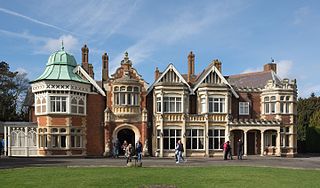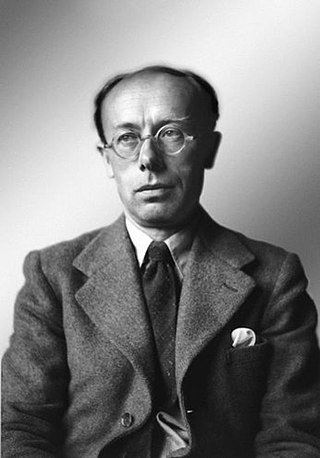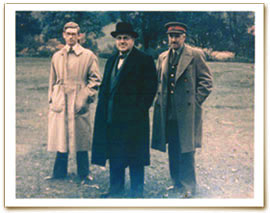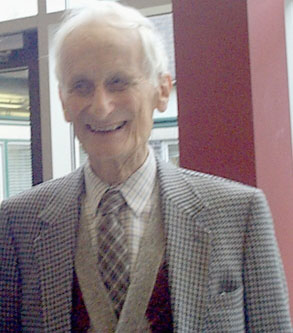Related Research Articles

Bletchley Park is an English country house and estate in Bletchley, Milton Keynes (Buckinghamshire) that became the principal centre of Allied code-breaking during the Second World War. The mansion was constructed during the years following 1883 for the financier and politician Sir Herbert Leon in the Victorian Gothic, Tudor, and Dutch Baroque styles, on the site of older buildings of the same name.

Cryptanalysis refers to the process of analyzing information systems in order to understand hidden aspects of the systems. Cryptanalysis is used to breach cryptographic security systems and gain access to the contents of encrypted messages, even if the cryptographic key is unknown.

Colossus was a set of computers developed by British codebreakers in the years 1943–1945 to help in the cryptanalysis of the Lorenz cipher. Colossus used thermionic valves to perform Boolean and counting operations. Colossus is thus regarded as the world's first programmable, electronic, digital computer, although it was programmed by switches and plugs and not by a stored program.

Maxwell Herman Alexander Newman, FRS,, generally known as Max Newman, was a British mathematician and codebreaker. His work in World War II led to the construction of Colossus, the world's first operational, programmable electronic computer, and he established the Royal Society Computing Machine Laboratory at the University of Manchester, which produced the world's first working, stored-program electronic computer in 1948, the Manchester Baby.

William Thomas TutteOC FRS FRSC was an English and Canadian codebreaker and mathematician. During the Second World War, he made a brilliant and fundamental advance in cryptanalysis of the Lorenz cipher, a major Nazi German cipher system which was used for top-secret communications within the Wehrmacht High Command. The high-level, strategic nature of the intelligence obtained from Tutte's crucial breakthrough, in the bulk decrypting of Lorenz-enciphered messages specifically, contributed greatly, and perhaps even decisively, to the defeat of Nazi Germany. He also had a number of significant mathematical accomplishments, including foundation work in the fields of graph theory and matroid theory.

Fish was the UK's GC&CS Bletchley Park codename for any of several German teleprinter stream ciphers used during World War II. Enciphered teleprinter traffic was used between German High Command and Army Group commanders in the field, so its intelligence value (Ultra) was of the highest strategic value to the Allies. This traffic normally passed over landlines, but as German forces extended their geographic reach beyond western Europe, they had to resort to wireless transmission.

The Lorenz SZ40, SZ42a and SZ42b were German rotor stream cipher machines used by the German Army during World War II. They were developed by C. Lorenz AG in Berlin. The model name SZ was derived from Schlüssel-Zusatz, meaning cipher attachment. The instruments implemented a Vernam stream cipher.

The Siemens & Halske T52, also known as the Geheimschreiber, or Schlüsselfernschreibmaschine (SFM), was a World War II German cipher machine and teleprinter produced by the electrical engineering firm Siemens & Halske. The instrument and its traffic were codenamed Sturgeon by British cryptanalysts.

Brigadier John Hessell Tiltman, was a British Army officer who worked in intelligence, often at or with the Government Code and Cypher School (GC&CS) starting in the 1920s. His intelligence work was largely connected with cryptography, and he showed exceptional skill at cryptanalysis. His work in association with Bill Tutte on the cryptanalysis of the Lorenz cipher, the German teleprinter cipher, called "Tunny" at Bletchley Park, led to breakthroughs in attack methods on the code, without a computer. It was to exploit those methods, at extremely high speed with great reliability, that Colossus, the first digital programmable electronic computer, was designed and built.
Cryptography was used extensively during World War II because of the importance of radio communication and the ease of radio interception. The nations involved fielded a plethora of code and cipher systems, many of the latter using rotor machines. As a result, the theoretical and practical aspects of cryptanalysis, or codebreaking, were much advanced.

Captain Raymond C. "Jerry" Roberts MBE was a British wartime codebreaker and businessman. During the Second World War, Roberts worked at the Government Code and Cypher School (GC&CS) at Bletchley Park from 1941 to 1945. He was a leading codebreaker and linguist, who worked on the Lorenz cipher system – Hitler's most top-level code.

Heath Robinson was a machine used by British codebreakers at the Government Code and Cypher School (GC&CS) at Bletchley Park during World War II in cryptanalysis of the Lorenz cipher. This achieved the decryption of messages in the German teleprinter cipher produced by the Lorenz SZ40/42 in-line cipher machine. Both the cipher and the machines were called "Tunny" by the codebreakers, who named different German teleprinter ciphers after fish. It was mainly an electro-mechanical machine, containing no more than a couple of dozen valves, and was the predecessor to the electronic Colossus computer. It was dubbed "Heath Robinson" by the Wrens who operated it, after cartoonist William Heath Robinson, who drew immensely complicated mechanical devices for simple tasks, similar to Rube Goldberg in the U.S.

Shaun Wylie was a British mathematician and World War II codebreaker.
The Newmanry was a section at Bletchley Park, the British codebreaking station during World War II. Its job was to develop and employ statistical and machine methods in cryptanalysis of the Lorenz cipher. It worked very closely with the Testery where a complementary set of operations were performed to complete the decryption of each message. Formally called the Statistical section, it was known as the Newmanry after its founder and head, Max Newman. It was responsible for the various Robinson machines and the ten Colossus computers. Some of the cryptanalysts had joint appointments with the Testery.

Peter John Hilton was a British mathematician, noted for his contributions to homotopy theory and for code-breaking during World War II.
Ralph Paterson Tester was an administrator at Bletchley Park, the British codebreaking station during World War II. He founded and supervised a section named the Testery for breaking Tunny.
Turingery or Turing's method was a manual codebreaking method devised in July 1942 by the mathematician and cryptanalyst Alan Turing at the British Government Code and Cypher School at Bletchley Park during World War II. It was for use in cryptanalysis of the Lorenz cipher produced by the SZ40 and SZ42 teleprinter rotor stream cipher machines, one of the Germans' Geheimschreiber machines. The British codenamed non-Morse traffic "Fish", and that from this machine "Tunny".
Cryptanalysis of the Lorenz cipher was the process that enabled the British to read high-level German army messages during World War II. The British Government Code and Cypher School (GC&CS) at Bletchley Park decrypted many communications between the Oberkommando der Wehrmacht in Berlin and their army commands throughout occupied Europe, some of which were signed "Adolf Hitler, Führer". These were intercepted non-Morse radio transmissions that had been enciphered by the Lorenz SZ teleprinter rotor stream cipher attachments. Decrypts of this traffic became an important source of "Ultra" intelligence, which contributed significantly to Allied victory.
References
- ↑ Kenyon 2019, p. 23.
- ↑ Good, Michie & Timms 1945, 1 Introduction: 14 Organisation, 14A Expansion and Growth, (b) Three periods, p. 28.
- ↑ "Code-Breakers: Bletchley Park's Lost Heroes". BBC. Retrieved 4 May 2015.